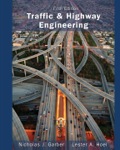
Concept explainers
(a)
The distance traveled by the vehicle when the acceleration is 45 ft/sec.
Answer to Problem 9P
Explanation of Solution
Given information:
Initial vehicle speed,
Final vehicle speed,
Concept used:
The time required by the vehicle upon acceleration is calculated by using the relation,
The distance travelled at any time is calculated by using the formula,
Calculation:
The time taken by the vehicle is calculated as,
Conclusion:
The distance traveled when the vehicle has accelerated to 45 ft/sec is
(b)
The time taken by the vehicle to attain a speed of 45 ft/sec.
Answer to Problem 9P
Explanation of Solution
Given information:
Initial vehicle speed,
Final vehicle speed,
Concept used:
The time required by the vehicle after accelerated is calculated by using the relation,
Calculation:
Conclusion:
The time for vehicle to attain speed of 45 ft/sec is
(c)
The acceleration of the vehicle after 4 seconds.
Answer to Problem 9P
Explanation of Solution
Given information:
Initial vehicle speed,
Final vehicle speed,
Time taken,
Concept used:
The initial velocity is calculated and then the acceleration is calculated.
Calculation:
Conclusion:
The acceleration after 4 seconds is
Want to see more full solutions like this?
Chapter 3 Solutions
Traffic and Highway Engineering
- The driver of the vehicle on a level road determined that she could increase her speed from rest to 51 kph in 36.80 seconds and from rest to 66 kph in 96.80 seconds. If it can be assumed that the acceleration of the vehicle takes the form:du/dt = α - βutwhere u is the vehicle speed in m/sec. Determine the maximum acceleration of the vehiclearrow_forwardA car moves according to the equation s = ut +1/2 at2, where s is the distance in meters , u is the initial velocity in m/sec, a is the acceleration in m/sec2 and t is the time in sec. Given that when t = 3 sec, s = 96.25 m and when t = 10 sec, s = 291. 667 m, determine the following: The value of u in kph The value of a in kph/sec The value of s in m when t = 15 secarrow_forwardAn automobile starting from rest speeds up to 40 meters per seconds with a constant acceleration of 4 meter per seconds square, runs at this speed for a time, and finally comes to rest with a deceleration of 5 meters per second square. If the total distance traveled is 1000 meters, find the (a) distance traveled covered during the acceleration, (b) distance traveled at constand speed, and (c) the total time of travel.arrow_forward
- Speedometer readings for a vehicle (in motion) at 4-second intervals are given in the table. t (sec) 0 4 8 12 16 20 24 v (ft/s) 0 5 17 31 39 38 28 Estimate the distance traveled by the vehicle during this 24-second period using L6, R6 and M3.L6 = R6=M3=arrow_forward5) A car is traveling along a straight road with an acceleration of a = 1/4 * s ^ (1/4) (m/s^ 2 ) Determine the velocity when the car travels 2 (m).arrow_forwardThe driver of the vehicle on a level road determined that she could increase her speed from rest to 51 kph in 36.80 seconds and from rest to 66 kph in 96.80 seconds. If it can be assumed that the acceleration of the vehicle takes the form du/dt = - βut where u is the vehicle speed in m/sec. Determine the maximum acceleration of the vehicle.arrow_forward
- 1.) From the traffic studies performed along a street shows the distances each vehicle traveled every 3 seconds on a portion of the highway. Vehicle Distance, m 1 82.6 2 89.9 3 84.6 4 82 a.compute the space mean speed of the traffic, in kph.b.compute the flow of traffic.c.compute the density of traffic.arrow_forwardThe brakes of a car are applied, causing it to slow down at a rate of 10 ft/s2. Knowing that the car stops 300 ft, determine (a) how fast the car was traveling immediately before brakes were applied, (b) the time required for the car to stop.arrow_forwardSHOW COMPLETE SOLUTION The dragster starts from rest and has an acceleration described hy the graph. Construct the v-t graph for the time interval 0≤ t ≤ t' where t' is the time for the car to come to rest.arrow_forward
- Five vehicles are traveling the highway from Point A to Point B at constant speeds. An observer at point A observes the five vehicles passing the designated point during an interval period of 29 seconds. Speeds of the vehicles are as follows : 55, 40, 45, 50, 32 kph. Calculate the flow in veh/hr. the final answer is 620.6897arrow_forwardYou are to determine the duration of the yellow light at a highway intersection. Assume that cars will be approaching the intersection traveling at 70 mph, and that the reaction time of the driver is 2.5 sec and that cars achieve a deceleration of 1/8 of the gravitational acceleration. if g=32.2 fps^2, a. how long must the traffic light remain yellow to allow drivers to come to stop before the traffic light turns red? b. what is the minimum distance of a car from the intersection when the lightturns yellow to ensure that it comes to a full stop before the intersection?arrow_forward. Cars A and B starts from rest at the intersection of two roads which makes an angle 60° with each other. Car A accelerates at 0.85 m/s2 and car B has an acceleration of 0.70 m/s2. Determine the relative displacement of the two cars 30 seconds after leaving the intersection. Determine the relative velocity of the two cars 30 seconds after leaving the intersection. Determine the relative acceleration of the two cars 30 seconds after leaving the intersection.arrow_forward
 Traffic and Highway EngineeringCivil EngineeringISBN:9781305156241Author:Garber, Nicholas J.Publisher:Cengage Learning
Traffic and Highway EngineeringCivil EngineeringISBN:9781305156241Author:Garber, Nicholas J.Publisher:Cengage Learning
